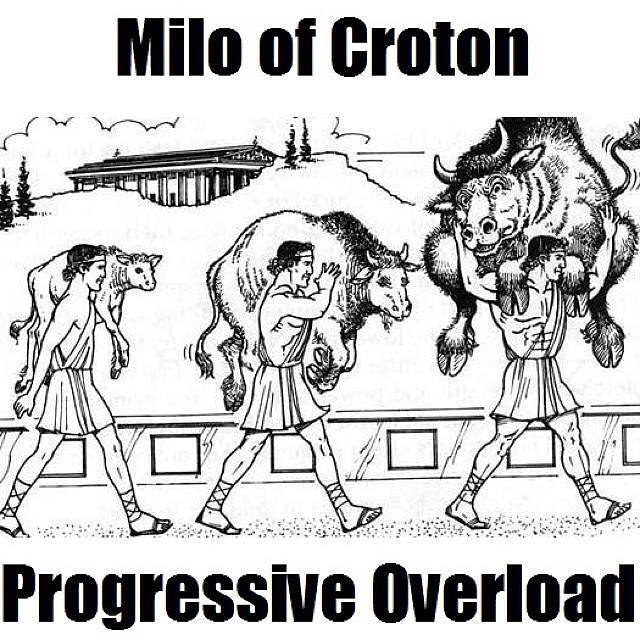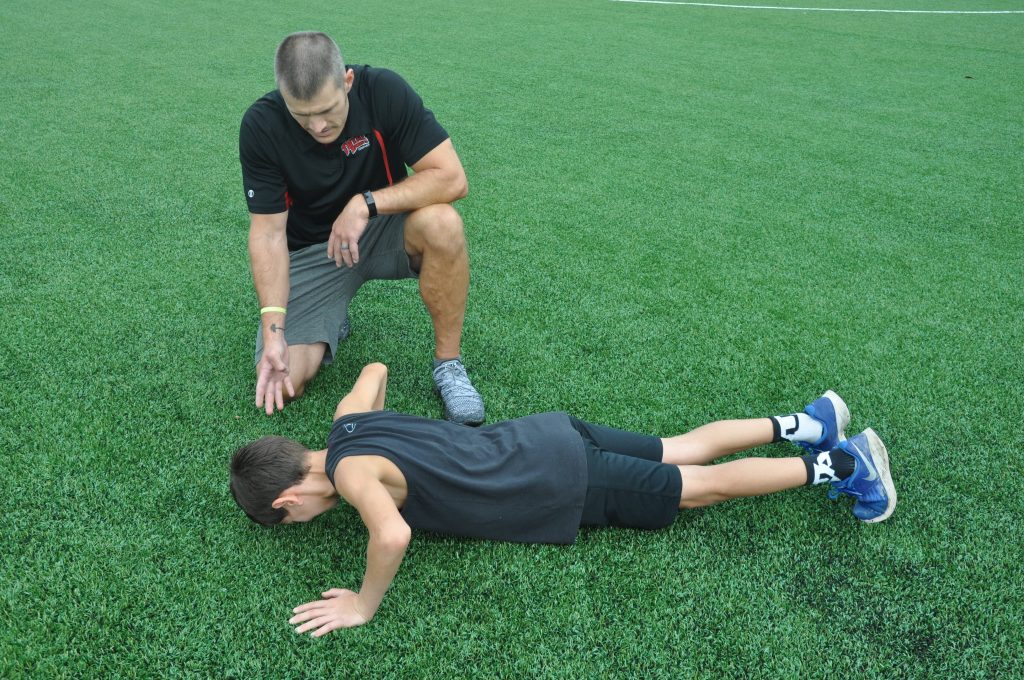
The principle of progressive overload is perhaps the most important concept for coaches to understand when developing athletes. It is one of the most basic differences between training and simply exercising. Unfortunately, this concept is often misunderstood and misapplied, especially when working with athletes under 18 years old. While developing athletes can be a very complex undertaking, I’d like to simplify the concept of progressive overload and discuss how to most appropriately apply it as part of an overall training program.
The most simplistic way to explain progressive overload is to slowly challenge yourself to do more than you’re currently capable of doing. Without some system of progression, we’re just burning calories and making athletes tired. Sure, they may benefit from exercise, but the process of training or developing athletes should be more systematic so they progress in the safest and most efficient manner possible.
The variables that can be manipulated when applying overload include:
- Frequency – how often the stimulus is applied
- Intensity – either the percentage an athlete’s maximum capability or the degree of effort that goes into an exercise
- Duration – how long the workout takes
- Volume – the total amount of work performed. This is generally represented as the weight x reps for strength training, but it can also be represented by the total amount of sets, number of reps or distance traveled.
Most of this article will focus on progressive overload for strength development, but speed & agility will also be discussed briefly.
Linear Progression
The essence of progressive overload is that your body adapts to a stimulus and slowly grows stronger or more efficient, depending on the goal. For example, if you can currently do 10 push-ups in a row, you would try to do 11. You would try to complete 11 push-ups until you can achieve that goal. The stimulus of attempting to do 11 forces the body to adapt and grow stronger. When you can complete 11, you begin working toward 12.
This is a very simple version of linear progression. Linear, meaning one variable, constantly moving in one direction. Many experts turn their noses up at this basic concept because progress eventually stagnates with most people, but it is a simple way to understand the underpinnings of progressive overload.

The story of Milo of Croton is another simple example of linear progression. Milo was a 6th-century Greek wrestler who picked up and shouldered a young calf when he was a young man. He picked up the calf every day as it slowly became a full-grown bull. Because he had lifted it every day, he gradually became stronger and was able to impress crowds of people by picking up bulls as an adult. The slowly increasing size of the bull provided a constant challenge that his body adapted to, and the concept of progressive overload was born.
Many athletes were developed through rough versions of this basic concept, and this was the inspiration for the adjustable barbell where small weights could be added to a bar in order to provide increasingly challenging stress.
Many coaches still take advantage of this simple strategy with relatively new trainees as they have athletes perform as many reps as possible of a single set of certain exercises. The results are recorded each day, and they are asked to “beat their score” in the next training session. This has the potential to turn into high-rep sets, but it works well when there is limited equipment and/or beginner lifters who will respond to even the lowest volumes. A basic workout for a young athlete could be one set of each of the following:
- Push-ups
- Chin-ups
- Sit-ups
- Single-leg squats
- Goblet squat
- Hanging leg raise
- Curl & press with dumbbells
- Inverted row

Something as simple as this routine could be a great way to teach beginner lifters how to slowly progress, execute quality reps, and push through the discomfort of strength exercises. Many coaches use a “20-rep set” where they prescribe one set of 20 reps of each exercise. Instead of giving the athlete a weight that can be lifted 20 times, they pick a weight that can only be lifted 10-12 times. Once fatigue sets in and no more reps can be completed, the athlete puts the weight down, rests for a few seconds, then attempts a few more reps. This is repeated until the athlete has performed all 20 reps. Only the first “set” (when the weight was put down the first time) is recorded, but the athlete stays with the exercise until all 20 reps are performed. If the athlete performed 13 reps on the first set today, the goal is 14 at the next session.
This is a way to utilize linear progression but also add extra volume to the workout because the athlete is essentially performing multiple sets. When the athlete can complete all 20 reps in one set, weight is added, a new exercise is prescribed or something else changes to increase the demands placed on the athlete.
Double Progression
This system gets at the essence of the “double-progression” method of progressive overload in which the resistance is increased when a certain number of reps is attained. A typical example would be to select a range of 8-12 reps. You could choose a weight that could be lifted at least 8 times, but no more than 12. Let’s say you can complete 10 reps today, but cannot do 11. In the next training session, you attempt to complete 11 reps. Once 11 reps can be completed, you attempt 12 reps at the next training session. When 12 reps can finally be completed (which is the top of the rep range we selected), the weight is increased the smallest amount possible, and you start the process over again, gradually trying to perform one more rep than you were able to get in the last workout.

This is an excellent way to help young athletes choose appropriate weights for their workouts, which is actually a very common issue in many weight rooms. Beginner lifters usually have no idea what an appropriate weight would be for each exercise, so they end up choosing weights based on what others are using. Testing is another way to help athletes choose weights for certain exercises, where a 1RM is established and percentages of that number are prescribed. But, this takes a lot of time, can be dangerous with inexperienced lifters, and often isn’t very accurate with young lifters. It’s also difficult (and not recommended) to establish 1RM’s for every exercise.
So, this system of gradually increasing the number of reps performed, then slowly increasing the weight, is a great way to help athletes learn how to choose appropriate weights.
Multi-Set Double Progression
Another way to implement this system is by using multiple sets of each exercise. Using multiple sets gives athletes more opportunities to practice technique, and the additional volume can provide a great training stimulus, especially for athletes who cannot push themselves hard enough to get maximum benefit from a single set.
In this case, prescribe a number of sets and reps for each exercise, for example, 3 sets of 8 reps or 3 x 8. In this example, athletes will use the same weight for all three sets and attempt to perform 8 reps on each set. When all 3 sets of 8 reps can be completed, the athlete gets to move the weight up the smallest amount possible at the next workout. If an athlete using 100 lbs can only perform 8 reps on the first set, 7 on the second, and 6 on the third, he/she will stick with 100 lbs on the next workout.
Many coaches will encourage athletes to perform as many reps as possible on the final set as a way to challenge athletes to push a little harder. This will also help you determine when they’re ready to increase the weight and how much the increase should be. In the above example, an athlete who performs all three sets of 8, but cannot do 9 reps on the last set, should increase the weight the smallest amount possible. On the other hand, an athlete who performs 15 reps on the final set is probably ready for a slightly larger increase in order to provide a more appropriate stimulus.
Different versions of this scheme have been used by intermediate and advanced lifters for many years with exceptional results. The idea is that the first set should end up being fairly easy, and allows for some technique practice. The second set becomes more challenging, and the third set is where the hardest work is done.
It’s also important for athletes to record their results somewhere so they can look back at how many reps they performed in the last workout as a way to set goals for the current session. Most young athletes aren’t going to remember they did 7 reps on the second set of bench press with 115 lbs. Most young athletes already have enough on their minds, so that needs to be recorded. A workout card or training software like TrainHeroic are great options for recording workout results.
Super-compensation
Teaching athletes about progressive overload is also an excellent way to teach the value of slow progression so they begin to understand the concepts of gradual adaptation, recovery, and super-compensation. Many young athletes think that they are going to get big and strong very quickly. Teaching them the value of consistency and gradual adaptation is an excellent concept for young athletes to understand so they begin to value small gains and how to schedule their workouts.
The graph below should be drawn out and explained to every athlete beginning a strength training program so they have a basic understanding of how the process works and why consistent training is so important.

Teaching athletes about progressive overload also gives coaches the opportunity to explain the value of recovery in the process of adaptation. Understanding how the cycle of stimulation – recovery – adaptation – super-compensation works is an invaluable lesson for athletes to learn. Most young athletes simply do not understand this cycle, and they end up either training inconsistently or too often. This also gives us the opportunity to explain how performance training fits into their overall schedule with sports practices, competitions, and other commitments. They need to see that all stress should be accounted for so they can create schedules that lead to progress in all areas.
Speed, Plyometrics, and Conditioning
While most of this discussion has been about strength training, progression should also be used with speed training, plyometrics, and conditioning. With plyometrics and speed training, progression is not quite as simple and easy to explain because technique and volume are so important to progression. You’re not adding another rep in every workout or increasing the number of repetitions every day. You can learn more about this type of progression in the IYCA’s Certified Speed & Agility Specialist course.
Conditioning programs are a little easier to quantify because coaches can easily manipulate variables such as number of reps, work;rest ratios, and total volume to gradually increase the demands placed on an athlete. It’s important to gradually build this volume rather than creating dramatic spikes just to make it extra difficult. Of course, there can always be a case made for making training difficult, but coaches need to be aware of how athletes will respond to large spikes in volume or intensity, and ensure that there is adequate recovery after this kind of session.
Periodization
As athletes get more advanced with their training, or enter their competitive seasons, we need to think about the concept of periodization. Through the years, I’ve seen coaches try to overcomplicate periodization and progressive overload with crazy set/rep schemes, charts, graphs, spreadsheets, and percentages that require a calculator. While certain systems of periodization can get very complicated for advanced athletes, we can (and should) keep things more simplified for most athletes who haven’t even entered college.

Most of these athletes would be considered beginners in the world of strength training, and some could be considered intermediate lifters at the very most. These trainees don’t need overly complicated programs, but we should definitely change the demands placed on them throughout the year. Off-season training programs (when athletes are not engaged in daily sport practice) can include a higher volume of strength training and the overall demands can be greater. During the pre-season, the amount of conditioning and sport-specific work will increase. Once daily practice begins during the in-season phase of the year, it’s important that we continue to train, but in a way that does not induce unnecessary fatigue.
This phase of training is difficult for both coaches and athletes to understand. Both groups often feel like brief training sessions are difficult to schedule and not worth it. Education is crucial here so they understand the importance of maintaining their strength gains without overly taxing their bodies. Inducing unnecessary fatigue will have a negative impact on both practice and competition performance, so the volume and intensity will be reduced. For example, an in-season athlete who has been training consistently for several months may still be able to squat during the season, but instead of doing multiple sets at a high rate of exertion, he/she may do only 1-2 sets, stopping each set before maximal fatigue sets in. This athlete also won’t train as often during the in-season phase. 1-2 training sessions per week are about all that’s possible during a demanding season.
Once athletes have a substantial training base, periodization becomes much more critical because experienced lifters will not make progress as easily as beginners. Complete books have been written on periodization, and many popular training programs have been devised, but most of these programs are unnecessary until athletes have trained consistently (without interruption) for at least a year and are no longer seeing significant progress. That doesn’t often happen before college, so we can do a much better with young athletes by simply monitoring training volume and intensity and understanding that strength training is meant to supplement a sport, not be the sport by itself.
Keep It Simple
When working with young or inexperienced athletes, it’s important for coaches to teach them about the training process so they have a better understanding of how they will make progress. Teaching athletes the basics of progressive overload, and using basic systems of progression, will give them an understandable framework in which to work from. They’ll be much better able to make consistent progress, choose appropriate weights, and train safely. They will also be much better prepared for more complex systems they may encounter if they advance in their athletic careers. It will also help them understand how to train for the rest of their lives.
Most coaches also see themselves as teachers or mentors, and teaching athletes the value of progression can be a gift that will pay dividends for the rest of an athlete’s life.
 Jim Kielbaso is the President of the IYCA and Owner of Impact Sports Performance in Novi, MI. He has authored multiple books, articles and training products and has spoken at events around the world. He holds a BS in Exercise Science, an MS in Kinesiology and has gone through multiple certifications through the IYCA, NSCA, NASM and more. Jim is a former college strength & conditioning coach and has trained thousands of athletes at every level of competition. He runs a successful NFL Combine training program in Michigan and has been hired as a consultant for major sports programs like the University of Michigan Football Program and the University of Kentucky Basketball Program.
Jim Kielbaso is the President of the IYCA and Owner of Impact Sports Performance in Novi, MI. He has authored multiple books, articles and training products and has spoken at events around the world. He holds a BS in Exercise Science, an MS in Kinesiology and has gone through multiple certifications through the IYCA, NSCA, NASM and more. Jim is a former college strength & conditioning coach and has trained thousands of athletes at every level of competition. He runs a successful NFL Combine training program in Michigan and has been hired as a consultant for major sports programs like the University of Michigan Football Program and the University of Kentucky Basketball Program.
The IYCA High School Strength & Conditioning Specialist is the only certification created specifically for coaches training high school athletes. The course includes several hours of video instruction and two textbooks with contributions from some of the top strength and conditioning coaches in America. Click on the image below to learn more about how to become a certified high school strength & conditioning coach.


